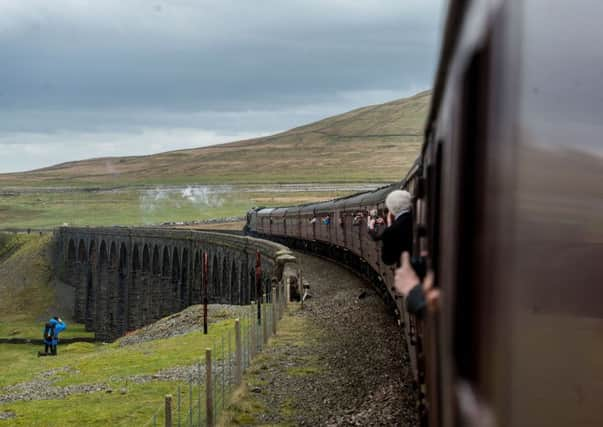Tom Richmond: Now is time to get behind investment in region's rail


As Flying Scotsman made the return journey to this county, this solitary figure – his farmer’s gait unmistakable – came into view. Dressed in his overalls, he slowly – and deliberately – doffed his peaked cap in silent acknowledgement of the historic locomotive’s very presence.
I’m not sure if he saw the steam train on its earlier journey to Cumbria – I’m assuming he was busy rounding up his sheep. Or, like those hard-to-please farmers he wanted to see the return trip before acknowledging a job well done.
Advertisement
Hide AdAdvertisement
Hide AdIt was a privilege to be part of railway history – the day that Flying Scotsman, the epitome of Yorkshire excellence, travelled along the railway line that refused to close to celebrate a feat of 21st century civil engineering after a £23m viaduct had to be built into a remote hillside to stabilise the trackbed following a landslide in which 500,000 tonnes of rain-sodden earth started tumbling hundreds of feet into the river Eden and its low-lying valley.
A symbolic event, it also revealed the depth of the public’s affection for the railways as people in their thousands secured prized locations to watch the Doncaster-built train – lovingly restored and maintained by York’s National Railway Museum – on its regal journey.
And this is important. Britain’s railways invariably make the headlines when there are hitches, whether it be late-running services due to the physical infrastructure not keeping pace with the country’s needs, unacceptable levels of overcrowding because of a chronic shortage of rolling stock or seemingly interminable industrial action.
Advertisement
Hide AdAdvertisement
Hide AdWhat Network Rail’s indomitable chairman Sir Peter Hendy, and the equally enthusiastic Rail Minister Paul Maynard, are determined to highlight is that the vast majority of trains do run on time and the number of journeys last year – 1.69 billion – dwarfs the 735 million when the railways were privatised a quarter of a century ago.
“I think for the nation that invented the railway, the steam train still has a special affection,” said Sir Peter with palpable pride as he listened in wonderment to the unmistakable sound of Flying Scotsman’s rasping whistle. “But people love the railway, even without the steam train.”
For proof, he cited the dozens of school children who greeted the train as it passed Settle – or the snaking line of cars parked on grass verges near Ribblehead – before explaining the sheer complexity of undertaking major engineering repairs while keeping disruption to a minimum.
For the aforementioned Minister whose interest in trains is genuine, unlike the tokenism of some of his predecessors, it is the economic value of the railways which is changing the terms of the policy debate more than half a century after local services were decimated by the short-sighted Beeching cuts.
Advertisement
Hide AdAdvertisement
Hide AdFor volunteers like the young Northern guard who volunteers for the Keighley and Worth Valley Railway which organised this journey of nostalgia to celebrate the 150th anniversary of the West Yorkshire heritage line, the goodwill of passengers – whether it be on steam trains or regular services – is tangible.
Yet they, and others, all agree that the 500,000 tonne landslip at Eden Brows near Armathwaite would, in the past, have been the excuse to close the Settle to Carlisle railway because of a shortage of funds.
Now, thanks to campaigners who fought so hard to keep this railway artery functioning for the benefit of commuters, freight traffic and the burgeoning leisure industry, there’s a wider acceptance that the railways are not just the lifeblood of the national economy, but also those rural communities that they serve.
As Network Rail’s chairman told The Yorkshire Post, just think what the morning or evening commute would be like if there were no trains. It’s a telling point from the University of Leeds graduate who became London’s transport commissioner before taking up his current role in January 2015.
Advertisement
Hide AdAdvertisement
Hide AdIt’s borne out by the questions posed once a month to transport Ministers in Parliament. A decade ago, they would centre on concerns about the possible closure of a branch line – a debate rendered redundant by the renovation of the Settle to Carlisle line.
Today, the exchanges reflect concerns that levels of investment by the Government – and others – are not keeping up with public demand and expectations. Though schemes like London’s Crossrail project are a national priority, the challenge is ensuring that the whole country benefits from this railway renaissance – including Flying Scotsman’s home county of Yorkshire.
After a journey like no other, I’ll never forget the crowds, large and small, that greeted Flying Scotsman – or the pride of all those who provided a truly first class service. I just hope the Minister remembers this show of support and presses the case for the planned investment in Yorkshire’s rail network to be accelerated still further – and not be sidetracked by HS2. If he does, he will have a legacy to rival his illustrious predecessor, Michael Portillo, who cites the decision to save the Settle to Carlisle line, including the famous Ribblehead Viaduct, as one of the most significant of his political career.
Now is the time to get behind the railways to ensure there’s no backtracking by the Government.